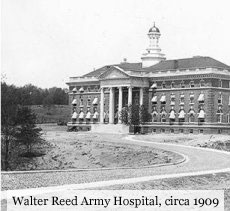© Constance J. Moore
Colonel, ANC (Retired), ANCA Historian

Army nurses have been essential to the operation of the Walter Reed Army Medical Center in Washington, DC, but not from the first day when the hospital was opened as Walter Reed General Hospital, on May 1, 1909. Nurses, in fact, were not assigned at the facility until two years later.
There are several stories about why this happened. One explanation is that the hospital commander who had previously commanded a hospital where the Army nurses went on strike1 refused to build an appropriate nurses' quarters within close proximity to the hospital, but rather offered accommodations near the horse barns at the far end of the post. The indignant Nurse Corps Superintendent, Miss Jane Delano, was said to refuse to assign Army nurses until better planning occurred. It is interesting to note that if this were true, Delano’s requirements were met. The nurses' quarters were built directly across from the hospital. The second depiction is less dramatic. It has been said that there simply were not enough Army nurses to meet the needs of all the hospitals and clinics in the Army system. Nurses essentially joined the staff when the nurses' quarters were completed.
No matter which story is correct—Army nurses were important to the hospital’s provision and administration of care from the very first day. Initially, with female nurses on staff, women and children could receive services along with male patients. Nurses, at this time, managed several vital administrative functions, such laboratory, rudimentary radiology services and medical records. Clinically, the nurses ran the wards and provided anesthesia in the operating room theaters. They ensured cleanliness standards so that infections were kept at a minimum.
Miss Jane Malloy, the first “Principal Chief Nurse” had many responsibilities besides supervising nursing. This is a humorous account of one of her adjunct duties:
Marketing for the nurses’ food service, or mess as it was called in those days, was a real problem, for the women found the heavy standardized military ration distasteful, preferring salads and other delicacies that the troops disdained. The Army ration had a cash value, raised from thirty to forty cents for the Army Nurse Corps of 1911, but even this increase did not ease the budgetary problem. Miss Molloy learned to her chagrin that in exchanging surplus ration commodities with the Commissary Sergeant she invariably got the short end of the financial arrangement, the wily Sergeant crediting her with the cost of lower priced items and charging for the higher, the profit to be applied to improving the meals served his own personnel. Green groceries and delicacies were procured in the city, and with market basket on her arm the Chief Nurse made the long trip by street car several times each week. Afternoon tea and dainty cakes were provided for her tired charges when ever funds were available, but this was not a standing arrangement, for the “tea fund” accumulated only from ten cent fines imposed on young ladies reporting on duty with their petticoats hanging below their uniform skirt.2
In 2011, one hundred years after the first nurse set foot at Walter Reed, Army military and civilian nurses assigned to Walter Reed faced another change. Walter Reed Army Medical Center closed its doors in Washington, DC, and opened up as a combined Army, Navy and Air Force hospital named Walter Reed National Military Medical Center in Bethesda, MD. The legacy of this great institution, and the first Army nurses who have served in it, will live on as it is moves forward into the future.
- For a description of this incident, see Sarnecky, M. (1999). A History of the U.S. Army Nurse Corps, Philadelphia: University of Pennsylvania, pp. 62-64.
- Standlee, Mary M. (1952). Borden’s Dream: The Walter Reed Army Medical Center in Washington, DC. Defense Department, Washington, DC, pp. 85-86.